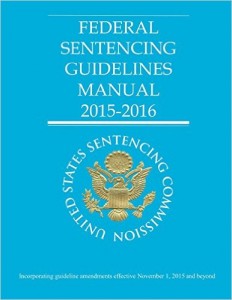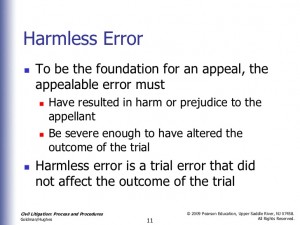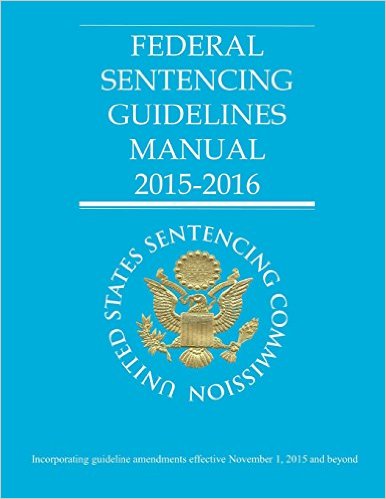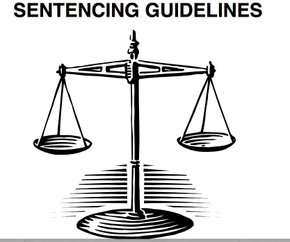Incorrect Calculation Of Federal Sentencing Guidelines And Plain Error
Molina- Martinez v United States
136 S.Ct. 1338
The United States Supreme Court
Decided: April 20, 2016
Issue: Whether the Fifth Circuit Court of Appeals could apply an “additional evidence” requirement on appeal when considering Rule 52(b)’s plain error analysis on appeal.
Holding: No. The United States Supreme Court held that the Fifth Circuit’s additional evidence requirement was unworkable and that a defendant who shows that the district court mistakenly deemed applicable an incorrect, higher range will, in the ordinary case, have demonstrated a reasonable probability of a different outcome. That showing will suffice for relief if Rule 52(b)s other requirements are met.
The United States Supreme Court found that a District Court’s use of an incorrect Guidelines range may go unnoticed. That error can be remedied on appeal pursuant to Federal Rule of Criminal Procedure 52(b), provided that (1) there is an error that not intentionally relinquished or abandoned, United States v Olano, 507 U.S. 725, 732-733; (2) the error is plain, i.e clear or obvious, id., at 734; and (3) the error affected the defendant’s substantial rights, ibid., which in the ordinary case means he or she must show a reasonable probability that, but for the error, the outcome of the proceeding would have been different, United States v. Dominguez Benitez, 542 U.S. 74, 82. Once these three conditions have been met, the court of appeals should exercise its discretion to correct the forfeited error if the error seriously affects the fairness, integrity or public reputation of judicial proceedings.
Facts: Molina-Martinez pleaded guilty to being unlawfully present in the United States after having been deported following an aggravate felony conviction, in violation of 18 U.S.C. 1326(a) and (b). As required, the Probation Office prepared a presentence report that related Molina-Martinez’s offense of conviction, his criminal history, his personal characteristics, and the available sentencing options. The report also included the Probation Offices calculation of what it believed to be petitioner’s Guidelines range. The Probation Office calculated that his criminal history warranted 18 points, which included 11 points for five aggravated burglary convictions from 2011. Those 18 criminal history points resulted in a criminal history category of VI. That category, combined with an offense level of 21, resulted in a Guidelines range of 77 to 96 months.
At the sentencing hearing, Molina-Martinez’s counsel and the Government addressed the court. The Government acknowledged that the Probation Office had recommended the low end on this case, 77 months. But, the prosecution told the court it disagreed with that recommendation?and was asking for a high sentence of 96 months?the top of the Guidelines range. Like the Probation Office, counsel for Molina-Martinez urged the court to enter a sentence at the bottom of the Guidelines range.
On appeal, Molina-Martinez’s attorney filed a merits brief arguing that the Probation Office and the District Court erred in calculating his criminal history points, resulting in the application of a higher Guidelines range. The error, Molina-Martinez explained, occurred because the Probation Office failed to apply 4A1.2(a)(2). That provision addressed that multiple sentences imposed on the same day are to be counted for purposes of determining a defendant’s criminal history. It instructs that, when prior sentenced were imposed on the same day, they should be counted as a single sentence unless the offenses were separated by an intervening arrest. Molina Martinez’s presentence report included five aggravated burglary convictions for which he had been sentenced on the same day; the probation officer counted each sentence separately, which resulted in the imposition of 11 criminal history points. In his view, the correct calculation should have resulted in 5 criminal history points instead of 11. That would have lowered his criminal history category from a VI to a V. The correct criminal history category, in turn, would have resulted in a Guidelines range of 70 to 87 months,?rather than 77 to 96 months. Had the correct range been used, Molina Martinez’s 77-month sentence would have been in the middle of the range, not at the bottom.
Molina- Martinez acknowledged that, because he did not object in the District Court, he was entitled to relief only if he could satisfy Rule 52(b)s requirements. He nevertheless maintained relief was warranted because the error was plain, affected his substantial rights, and impugned the fairness, integrity, and public reputation of judicial proceedings; the Court of Appeals disagreed. The Court of Appeals held that when a correct sentence range overlaps with an incorrect range, the reviewing court does not assume, in the absence of additional evidence, that the sentence imposed affects a defendant’s substantial rights. 588 Fed. Appx. 333, 335 (CA5 2014); United States v Blocker, 612 F. 3d 413, 416 (CA 2010). The Court held that Molina-Martinez did not put forth the additional evidence necessary to show that the error affected his substantial rights. The United States Supreme Court granted certiorari to resolve the disagreement among the Court of appeals over how to determine whether the application of an incorrect Guidelines range at sentencing affected the defendant’s substantial rights. The Court concluded that the error affected defendant’s substantial rights and reversed.
Legal Analysis: The United States Supreme Court held that the Court of Appeals can not apply a categorical additional evidence rule in cases, like this one, where a district court applies an incorrect range but sentences the defendant within the correct range. The Guidelines are to be the sentencing court’s starting point and initial benchmark, Gall v United States, 552 U.S. 38, 49 (2007).
The Guidelines establish the essential framework for sentencing proceedings. Sentencing courts, must begin their analysis with the Guidelines and remain cognizant of them throughout the sentencing process, Peugh v United States, 569 U.S. ___,___. Sentencing Commission statistics confirm that the Guidelines inform and instruct the district court’s determination of an appropriate sentence. In the usual case, the systemic function of the selected Guidelines range will affect a defendant’s sentence. As a result, a defendant who shows that the district court mistakenly deemed applicable an incorrect, higher range will, in the ordinary case, have demonstrated a reasonable probability of a different outcome. That showing will suffice for relief if Rule 52(b)s other requirements are met, Pp. 9-12.
The Guidelines are complex, and so there will be instances when a district court’s sentencing of a defendant within the framework of an incorrect Guidelines range goes unnoticed. In that circumstance, because the defendant failed to object to the miscalculation, appellate review of the error is governed by Federal Rule of Criminal Procedure Rule 52(b).
 Rule 52, in both of its parts, is brief. It states:
Rule 52, in both of its parts, is brief. It states:
(a) Harmless Error: any error, defect, irregularity, or variance that does not affect substantial rights must be disregarded.
(b) Plain Error: A plain error that affects substantial rights may be considered even though it was not brought to the courts attention. The starting point for interpreting and applying paragraph (b) of the Rule, upon which this case turns, is the Courts decision in United States v Olano, 507 U.S. 725 (1993). Olano instructs that a court of appeals has discretion to remedy a forfeited error provided certain conditions are met.
The Court held that the unworkable nature of the Fifth Circuits additional evidence rule is evident here, where the record shows that the District Court gave little explanation for the silence it selected, rejected the Governments request for a sentence at the top of the erroneous Guidelines range, and chose the sentence requested by the defendant and recommended the Probation Office?a sentence at the bottom of the erroneous Guidelines range. This demonstrated that the Guidelines range served at the starting point for the sentencing and were the focal point for the proceedings that followed. Given the sentence the District Court chose, and because the court said nothing to suggest that it would have imposed the same sentence regardless of the Guidelines range, there is at least a reasonable possibility that the court would have imposed a different sentence had it known that 70 months was the lowest sentence the Commission deemed appropriate. Pp. 12-13.
The Federal Sentencing Guidelines first enter the sentencing process when the United States Probation Office prepares a presentence report containing, as relevant here, an advisory Guidelines range based on the seriousness of a defendant’s offense and the extent of his criminal history. A district court may depart from the guidelines, but it must consult them and take them into account when sentencing, United States v Booker, 543 U.S. 220, 264. The Guidelines range in his presentence report was 77 to 96 months. He requested, and the Probation Office recommended, a 77-month sentence while the Government requested 96 months. The District Court, with little explanation, sentenced him to the lowest end of what it believed to be the applicable Guidelines range ?77 months.
On appeal, Molina-Martinez argues for the first time that the Probation Office and the District Court miscalculated his Guidelines range, which should have been 70 to 87 months, and noted that his 77-month sentence would have been in the middle of the correct range, not at the bottom.
 The Fifth Circuit agreed that the District Court used an incorrect Guidelines range but found that the error affected his substantial rights. It reasoned that a defendant whose sentence falls within what would have been the correct Guidelines range must, on appeal, identify additional evidence showing that use of the incorrect Guidelines range in fact affected his sentence. This framework applies to errors in the calculation of an advisory Guidelines sentence. If the defendant does not call the error to the attention of the sentencing judge, the defendant may obtain relief on appeal only if he or she proves that the error was prejudicial?specifically, that there is a reasonable probability that, but for the error the sentence would have been different, United States v Dominguez Benitez, 542 U.S 74, 81-83(2004). Meeting this burden should not be easy for defendants, Id., at 82.
The Fifth Circuit agreed that the District Court used an incorrect Guidelines range but found that the error affected his substantial rights. It reasoned that a defendant whose sentence falls within what would have been the correct Guidelines range must, on appeal, identify additional evidence showing that use of the incorrect Guidelines range in fact affected his sentence. This framework applies to errors in the calculation of an advisory Guidelines sentence. If the defendant does not call the error to the attention of the sentencing judge, the defendant may obtain relief on appeal only if he or she proves that the error was prejudicial?specifically, that there is a reasonable probability that, but for the error the sentence would have been different, United States v Dominguez Benitez, 542 U.S 74, 81-83(2004). Meeting this burden should not be easy for defendants, Id., at 82.
Instead, the standard should be robust enough to enforce the policies that underpin Rule 52(b) generally, to encourage timely objections and reduce wasteful reversals by demanding strenuous exertion to get relief for unpreserved error. Ibid. By placing this burden on the defendant Rule 52(b) compels defense counsel to devote careful attention to the potential complexities of the Guidelines at sentencing, thus providing the district court?which is ordinarily in the best position to determine the relevant facts and adjudicate the dispute?with the opportunity to consider and resolve any objections, Puckett v United States, 556 U.S. 129, 134 (2009); see also ibid.
Whether a defendant can show a reasonable probability of a different sentence depends on the particular facts and circumstances of each case, United States v Davila, 569 U.S. ___,___-___(2013) (slip op., at 13-14). The United States Supreme Court has previously warned against courts determining whether an error is harmless through the use of mandatory presumptions and rigid rules rather than case-specific application of judgment based upon examination of the record, Shinseki v Sanders, 556 U.S. 396, 407 (2009)(citing Kotteakos v United States, 328 U.S. 750, 760 (1946)). Instead of relying on presumptions, a court of appeals must engage in a full record assessment to determine whether a defendant who forfeited a claim of Guidelines error has met his case-specific burden of showing prejudice, Davila, supra, at ___(slip op., at 14). The answer may be affected by a variety of factors, including any direct evidence, the nature and magnitude of the error, the sentencing judges view of the Guidelines, the approach of the circuit in question, and the particular crime at issue.
Under the specific circumstances here, Molina-Martinez met his burden. As the Court holds out, Molina-Martinez demonstrated that the Guidelines were the focal point for the proceeding; that the 77-month sentence the District Court selected is conspicuous for its position as the lowest sentence within what the District Court believed to be the applicable range; and that a District Courts selection of a sentence at the bottom of the range, despite the Governments request for the maximum Guidelines sentence, evinced an intention to give the minimum recommended by the Guidelines. Ante, at 13. This evidence establishes a reasonable probability that the District Court would have imposed a different sentence had it known that the 70 months ,was, in fact, the lowest sentence the Commission deemed appropriate.
The Fifth Circuit applied exactly the sort of strict, categorical rule against which the Court has warned. Under the Fifth Circuits approach, Molina-Martinez could not satisfy his burden with circumstantial evidence regarding the parties sentencing arguments or the District Courts selection of a sentence at the very bottom of the range. The manner in which a district court applies an incorrect Guidelines range can itself serve as evidence of an effect on substantial rights. Accordingly the United States Supreme Court reversed and remanded the order of the Court of Appeals.

